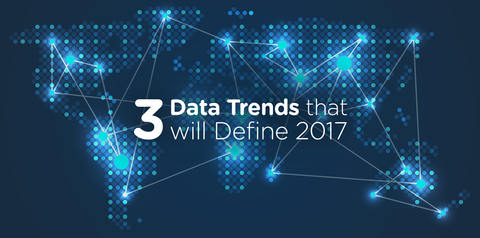January 2, 2017
Submitted by
2017 is nigh, and it’s the time of the year to look into the crystal ball and try to predict what the future holds for us. Here are the trends we think will go big in the coming year and what businesses need to watch out for:
1. Emergence of Data Converging Platforms
Wearables are ubiquitous; everyone worth their salt is jumping on the Internet of Things (IoT) bandwagon; and Augmented Reality (AR) is here to stay. These are the current favorite trends in the industry; and based on what we’ve seen in the recent years, we think it’ll be mostly how businesses apply these trends that will drive the growth of these technologies, not the end users.
And here is why - the data generated by these three technologies is incredibly voluminous, we all know that. It might not be of much use to an individual user, but in large volumes can be incredibly useful to businesses. If we can handle its relentless onslaught, this data can especially provide us deep real-time analytical insights that can help brands understand their consumers far better and make data-driven decisions.
Data-converging platforms that will converge the influx of all connected data will rise in 2017, fuelled by the demand to tame this massive data. A converged platform has a lot to offer - from richer analytical insights, leading to focused product development, in turn leading to higher Return on Investments (ROI). A consistent and unified framework for development will bring down DevOps costs and can even provide a unified administration framework to monitor and analyze the influx of data.
2. Increased Adoption of Artificial Intelligence (AI)
Like it was with big data a few years back and then machine learning a little later, AI is the current buzzword that has got everyone excited.
And for a reason - AI marries powerful machine learning models with efficient analytical algorithms. The result is intelligent automation and Natural Language Processing (NLP) that can help us understand human behavior that just models or just analytics separately cannot.
According to the recent study, overall AI market is expected to be worth $16.06 Billion by 2022, growing at a CAGR of 62.9% from 2016 to 2022.
We believe that the reason for this tremendous interest and excitement is simple and well-deserved. AI will strengthen real-life analyses and enable us to draw deeper, more meaningful, and relevant conclusions that will help us build insights and make connections that we have so far not been able to tap into.
AI will not only have a tremendous impact in the field of digital marketing, but also customer service because we see it as a powerful tool for enhancing the overall customer experience.
As brands adopt AI, they will explore and try to find the best ways to use it for their business, and help them solve problems in an efficient and faster manner.
3. Uncomplicating Data - Solution by Design
Think of the best products and applications you have used. It certainly wouldn’t be the ones that were full of latest and greatest features; what most probably would be on your top 5 list would be the ones that were simple to use, were intuitive, and were clean! Great design is the key to great products.
Complexity is a strict no-no in the world of user experience. But when you are dealing with 10 TBs of distributed data in less than a day, complexity is all you can expect. However, complex need not and must not(!) be complicated. Complexity may be unavoidable if your workflows are complex, but just because your productis handling and processing an onslaught of complex data is not a valid excuse for bad design or a difficult interface.
In the coming years, with every other solution dealing with complex, real-time data and analytics, the differentiator will be how you simplify the data and how simple and user-friendly you present your solution to be. The key will be “data-driven” and “informed” design, thinking beyond complicated algorithms, analytics, and automation, and deeply understanding the real-world user workflows.
By Anil Mathews, Founder and CEO of Near

